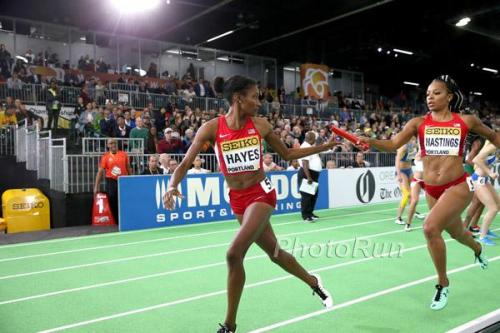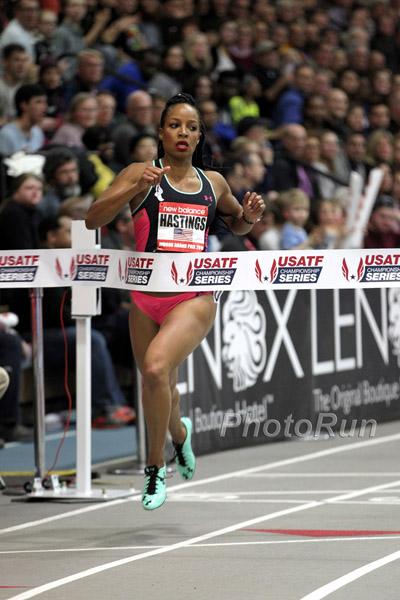 Natasha Hastings, NBIndoorGP2016, photo by PhotoRun.net
Natasha Hastings, NBIndoorGP2016, photo by PhotoRun.net
David Hunter told me that he was very proud of his piece on Natasha Hastings. I agree, it is one of his finest. Natasha Hastings is one of our most talented, hardworking and focused athletes. She is an amazing example of how fantastic the athletes in our sport can be. Natasha is also terribly bright, as the winner of her Conference Scholar Athlete while under the thoughtful coaching of Coach Curtis Frye.
I look at Natasha Hastings and see, not only a relay gold medalist 8 times over, but individual medals in her future. We will watch her closely in 2017 and beyond.
December 30th, 2016
Every once in a while, you can uncover a world-class United States track & field athlete whose journey to stardom reinforces the hope that our country can still identify future elite performers and steer them to the path that allows them to achieve full potential as an athlete and, more importantly, as a person. Natasha Hastings is one such athlete.
Born and raised in the maelstrom that is New York City, the young Hastings didn’t get lost in the shuffle. As a 16 year old, she won the 400 meters [53.41] in the 2003 Youth Girls Division of the USATF Junior Olympics. That achievement did not go unnoticed. With the double barreled benefit of attending A. Philip Randolph Campus High School – a Harlem-based institution known for its blend of top flight academics and athletics – Hastings bloomed as a student and as an athlete. “It was kind of like the best of both worlds,” notes Hastings. “There was a good track program at Randolph, but I was also going to a good school.” It is no surprise that the nearby Armory would play a role in her development. “On my gosh, the Armory was like home,” declares Hastings excitedly. “I’m pretty familiar with the Armory and I sure know my way around that building.”
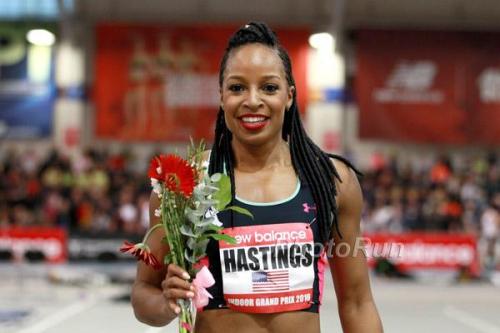 Natasha Hastings, photo by PhotoRun.net
Natasha Hastings, photo by PhotoRun.net
After capturing a World Junior Championship [52.04] the following year, Hastings was off to Columbia, South Carolina to enter the Gamecocks’ pre-med program and, of course, continue her development as one the most promising long sprinters in the country.
How did a New York native find her way to the Deep South? “I kind of watched them from very early on. I knew I wanted to be a Gamecock – probably as early as my freshman year in high school,” Hastings reveals. “Coach [Curtis] Frye had the reputation as being a great hurdle coach and a great quarter miler coach. So it was kind of like I knew that was where I wanted to be.”
Now aligned with one of the most respected and accomplished coaches in the country, the young sprinter and the her collegiate coach hit if off well. “I thing I liked a lot about Coach Frye’s program and the thing I developed the most in his program was speed,” explains the two-time Olympian. “He was not a fan of utilizing a lot of long distance. I did a lot of my base work with the cross country team. But when it came to developing my speed, he was very much on board with that. And the philosophy was the faster my 200 was, the faster my 400 would be. We kind of figured that out as soon as I got there and we saw immediate returns in that way.”
Hastings and Frye worked together to break down the 400 meters – one of track & field’s trickier events. The mentor and pupil analyzed the race in sequential segments, constructing a game plan for attacking the one lap race. “I think every runner, every athlete has to find their own style. As far as breaking the race down, I think it is pretty standard that you break the race down into four 100 meter segments. That initial step probably doesn’t change much. But how you run those four 100 meter segments can be different,” emphasizes Hastings. “I think every athlete develops a plan to the best of their strengths. Athletes who are powerful may come home stronger, but don’t necessarily take it out faster at the beginning. The key is figuring out who you are, your strength in running, and then mastering it.”
Natasha Hastings attacks the 400 meters in a manner that reflects her personality: boldly, and with confidence. “I would definitely say I am a gutsy 400 meter runner. I like to put it out in front. I trust my speed and I trust my strength,” she reveals. “I feel like that there is a very different energy system at the front of the race that I’m never going to get back. So rather than let it go to waste, I’d rather use it up front and trust my training, my strength, and my speed to come home.”
But, Natasha, what about varying circumstances? Do you employ different strategies for different situations – a single race; a championship series of rounds; the anticipated strength of your opponents? “A part of me wants to say no. But then the realistic part of me says, ‘Absolutely!'” she waffles coyly. “I’m a firm believer in not changing the game plan when you get to the big stage. It was good enough to get you there. I think many mistakes people make in the championships derive from thinking they need to try something different. And I don’t think that’s the case,” states the veteran of the world’s biggest stages. “But what I do think is that you have to manage the adrenalin, the rounds, those types of things. But I don’t think you necessarily have to change your style or your form of execution.”
By 2007, it was clear the 20 year old had figured it out. Hastings had a spectacular breakout year – winning both the NCAA indoor [50.80 – a collegiate record] and outdoor [50.15] titles, posting a PR 49.84 to finish as the USATF outdoor runner-up to Dee Dee Trotter, and earning her #5 USA and #9 World rankings by Track & Field News.
But for Hastings, perhaps the most treasured accolade of that magical year was her recognition as the Southeastern Conference Scholar Athlete of the Year. “From a very early age, my mom made it clear that academics was going to be important, that I can’t run for the rest of my life,” explains Hastings. “I do plan to move on and do something else [after track & field]. When I went to South Carolina, I had hopes of going on to become a chiropractor. I am still toying with the idea of going back in order to become a chiropractor. The scholar athlete recognition, along with being a member of the honor society and graduating with a 3.6 GPA, are accomplishments to celebrate and be proud of.”
As a global team relay veteran, Hastings knows about the often-time awkward teammate dynamics, the frequent politics shrouding the coach’s lineup decisions, and the emotional roller coaster all relay artists ride. “Keeping everyone happy is kind of an impossible thing. It is a tough job for the coach. The decisions are definitely hard ones – not easy by any means,” reveals Hastings who has seen the selection process from both sides, having run the 4×4 prelim and not the final in the ’08 Olympics versus not racing the long relay’s preliminary round and being swapped in to run the final at the Rio Games. “There are relationships that are built on these teams. Having to make the call can sometimes be very hard and often political. For me that is neither a good nor a bad thing,” notes Hastings who also competed in the all three rounds of the open 400m in the 2016 Games. “I have been in the system for so long that I kind of understand that this is a call that has to be made and will be made – so just be prepared for it. In most circumstances, you kind of know what kind of call will be made. Sometimes, it may be more political than based on performance or vice versa. But sometimes you get a sense of what the call is going to be. And when you’re not one of the final four, it’s a tough one – I’m not going to lie,” explains Hastings who ran the all-important 2nd leg in the Rio 4x400m final.
“The thing about Rio was it was my second Olympics, but in a lot of ways it was my first: my first individual appearance; my first time running 400m prelims and then the final. In 2008, I only ran the relay prelim and this year I only ran the final. I remember what it is like in ’08 to face the final, to want to be out there so badly, and I wasn’t.
And this time around it was different. But as an athlete who has won 11 long relay medals – 8 of them gold – in either the Olympics or world championships, Hastings has found a positive aspect to this sometimes brutal, but always necessary ritual. “I know it sounds cliché, and as hard as it was then, I am grateful for those moments. Now that I have the opportunity to be on the other side, I am so much more grateful and appreciative of where I am, because I can truly say that I feel like I’ve paid my dues and I’m worth my weight where I am.”
Quenara Hayes from Natasha Hastings, World Indoors 2016, photo by PhotoRun.net
Hastings knows that with a wildly-successful American record holder like Sanya Richards-Ross retiring and a bevy of young talent led by Bowerman Award honoree Courtney Okolo and Ashley Spencer moving up, the always-talented elite American field in the women’s 400m is undergoing a transition. Could this transformation open the door for a breakthrough year for the 30 year old veteran in her prime?
“I think so. 4 years ago when I didn’t make the team, I contemplated quitting, going back to school to enter the chiropractic field, to get a regular job. And then slowly but surely every year, I’ve just worked myself closer and closer and closer. And I made the team [in ’16].
This year to make the team I was so close to my PR. I honestly feel that I am getting into the best shape of my life – not only physically, but mentally. People ask me what the difference is between now and 4 years ago [when I didn’t make the team]. And honestly, I think a big part of it is my mental training and the experience I have gained over the years. I think about going through the rounds at the Trials for the hardest team in the world to make. Going through the rounds at the Olympics, and now the world championships, there is an experience earned over the years that is just invaluable. I really treasure that. And I feel like next year is going to be a big year. I hope that the next 4 years are going to be great and successful for me. By no means am I hanging up my shoes. I am just coming into my own.”
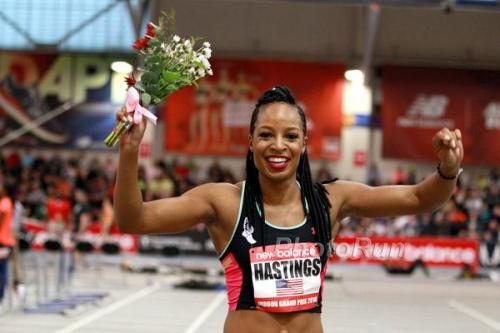 Natasha Hastings, photo by PhotoRun.net
Natasha Hastings, photo by PhotoRun.net
Natasha Hastings knows that winning that elusive individual Olympic medal would make her already-impressive track & field résumé complete. And while her 4th place finish in the Rio 400m final was a painful disappointment, Hastings draws inspiration from her semi-final clocking just .06 seconds from her 9-year old PR. “The Olympics were definitely a bittersweet moment for me – more sweet, than bitter. It was definitely eye-opening. It is one thing to go into something believing that you can do something and then come either really close to achieving it or have it actually happen. It kind of opens your eyes to what the possibilities are,” states the 400 meter veteran in sharing her feelings. “I remember running that 49.84 nine years ago and what that felt like. And then I go back to what that 49.90 [in the Rio semis] felt like. And I just keep reminding myself: if the 49.90 was that easy, then there is way more in the tank. I just remember walking off the track after my semi-final race. It was the biggest confidence booster.”
Hastings – who is coached by Darryl Woodson – sees that semifinal time as a positive omen of what may be to come. “Looking forward to 2017, I am excited. My training has gotten me off to a great start. I’m really looking forward to this season,” adds Hastings who will kick off the new year by racing over 300 meters at the 110th Millrose Games.
A look back at Hastings body of work in 2016 does indeed suggest that she has reason for optimism in the coming world championship year. All in all, it was an impressive year for the Under Armor and New York Athletic Club athlete: relay golds in the world indoor championships and the Olympics; a near miss at an individual medal in the Rio 400m; 2nd place in the race for the Diamond League 400m trophy with a win in Paris; and 2016 time rankings of #3 on the USA list and #5 on the world chart.
Natasha Hastings knows how she wants to be remembered by the sport she loves. “I want to be remembered as the girl who never gave up,” says the multiple-time Olympic gold medalist without hesitation. “At times, there were certainly a lot of people who counted me out, including myself. I counted myself out. But I kept my faith. I kept my head down. And I just kept working at it,” she explains. “After the final of the individual 400m, I remember walking off the track feeling absolutely gutted. There are no other words for it. I felt shallow. I felt empty. I thought, ‘How could this be happening?'”
After an evening of consolation with her family and her long-time global championship roommate Michelle Carter, she faced the next day. “I woke the next morning. I opened my phone and I expected my Instagram to show nothing but negative comments. But the outpouring of love from people was amazing: they could relate to my story; they watched my journey; some felt they were on my journey with me.
Sure, I was disappointed that I don’t have the hardware that I went there hoping for. And I came so close. But to know that so many people are inspired by my story is uplifting. I remember that it was 20 years ago when I was watching the Olympic Games saying ‘One day I want to be an Olympian.’ And now I see little girls brightly saying the same thing.”
After a brief moment of reflection, Natasha Hastings adds one final thought. “I realize this is why I do it, why I step out on the track. If I can be an inspiration to anyone, that is a gift that is real.” Dave Hunter
Author
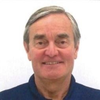
Dave Hunter is an award-winning journalist who is a U.S. Correspondent for Track & Field News. He also writes a weekly column and serves as Senior Writer for www.RunBlogRun.com, and covers championship track & field competition domestically and in such global capitals as Moscow, Birmingham, Zurich, Brussels, Beijing, Rio de Janeiro, Zagreb, Ostrava, and Doha. Hunter frequently serves as the arena or stadium announcer for championship track & field gatherings, including the Ivy League, the Big East, the Mid-American Conference, the NAIA, the Big Ten, and the Millrose Games. Hunter has undertaken foreign and domestic broadcast assignments. He ran his marathon P.R. 2:31:40 on the Boston Marathon course back in the Paleozoic Era. To find out more about Dave, visit his website: www.trackandfieldhunter.com He can be reached at: dave@trackandfieldhunter.com
View all posts

